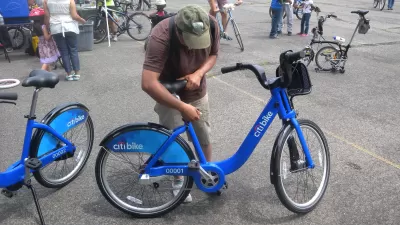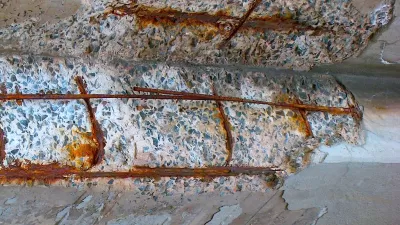Hurricane Sandy
The Promise and Perils of Modern Disaster Communications
During and after Sandy, transportation workers had the responsibility of informing riders of changing conditions and schedules. Ray Rivera compares the different communication approaches of New Jersey Transit and the Long Island Rail Road.

New York's Next Post-Industrial Success Story?
Michael Kimmelman tours Fresh Kills landfill, once the world's largest garbage dump, and now a model for landfill reclamation and, unexpectedly, climate change mitigation.
How New York Failed Its Neediest After Sandy
In an expose that many have been clamoring for since the days immediately following Sandy when stories of people stranded in NYC's public housing came to light, the Times explores how NYCHA and the city were unprepared for the storm's aftermath.

NYC Bike-Share Gets Delayed Again
On Friday, New York City announced yet another postponement for the launch of its long-awaited bike-share program. While faulty software was reportedly the cause for the initial delay, Superstorm Sandy can be blamed for the most recent problems.
Bloomberg Backs Beachfront Rebuild
In a speech Thursday, Mayor Bloomberg laid out his strategy for rebuilding a stronger, smarter New York in anticipation of future natural disasters.
Sand Dunes Prove Their Worth Along the NY Shore
Surfers, local businesses and residents alike rallied against kicking in $7 million for an Army Corps of Engineers plan to elevate beaches and erect sand dunes in Long Beach, NY six years ago. Post-Hurricane Sandy, most regret this choice.
NYC's Real Estate Market Continues to Feel Sandy's Effects
Alexei Barrionuevo looks at how New York's real estate market has been impacted by the severe blackouts and flood damage from Hurricane Sandy. How long will the market for certain areas continue to feel Sandy's effects?

How Robert Moses Put NYC's Poor in Sandy's Path
Recently a destination for luxury development, New York's waterfront has historically been home to the city's poor. When Sandy inundated these vulnerable populations, it "looked like a perverse stroke of urban planning," writes Jonathan Mahler.
MTA Disaster Aid Request: Appropriate or Overreach?
This week, New York's Metropolitan Transportation Authority made public its request for $5 billion in federal aid to rebuild what was damaged during Superstorm Sandy. But a look at the details reveals an ambitious agenda for improvements.
Sandy's Enduring Environmental and Public Health Disaster
The raw and partially treated sewage that has for the past month, and continues to, flow into the New York region's waterways "will be one of the most enduring and expensive effects of Hurricane Sandy," reports Michael Schwirtz.
The Cost of Exclusivity in Gated Communities
Gated communities such as Sea Gate in Brooklyn and Breezy Point in Queens "have long held the rest of the city at arm’s length." Following Hurricane Sandy, residents are now seeking financial assistance from the city to rebuild their homes.
NYC Studies How to Build Resiliency
In the wake of Superstorm Sandy, a new task force convened by New York's Mayor Michael R. Bloomberg and City Council speaker Christine C. Quinn will look into potential changes to the city's building code, with recommendations due next summer.
After the Storm, Public Housing Still Needs a Boost
The New York City Housing Authority is facing scrutiny after residents went almost a month without power, Nicole Anderson reports.
Sandy Inspires Solar Companies to Rework System
Hurricane Sandy caused power outages that also prevented the use of hundreds of solar panels in the greater New York area. Solar companies are now working on decentralizing the system to make solar energy a backup source, reports Diane Cardwell.
Rising to the Real Challenge of Sandy
Michael Kimmelman takes a hard look at the political and bureaucratic obstacles that stand in the way of a forward-thinking approach to rebuilding in the wake of Hurricane Sandy.
The Secret Plans for Containing New York's Next Housing Emergency
Hurricane Sandy exposed the need for New York City to be able to house large numbers of residents following natural disasters. Matt Chaban examines the Bloomberg administration's "secret" plan to build modular apartments out of shipping containers.
How Can Architects Help in Disaster Relief?
Using post-Sandy New York as a case study, C.J. Hughes looks at the extent to which architects can be helpful in the immediate aftermath of a natural disaster.

Why Do Americans Put Up With Decaying Infrastructure?
Compared to Europe's high-speed rail, paved roads, and underground power lines, America lags behind with its unreliable trains, potholes, and overhead power lines. Uwe E. Reinhardt questions why Americans put up with the decaying infrastructure.
After Sandy, NYC Will Undertake Unprecedented Reshaping of Neighborhoods
Over the weekend it was announced that New York City will need to demolish hundreds of homes damaged during Superstorm Sandy. The complicated process for determining what will be rebuilt has yet to begin.
Sandy Was a Double-Edged Sword for Bikes in NYC
In the immediate aftermath of Superstorm Sandy, bicycles appeared to be the big winner in the ensuing transportation chaos. This week, however, it was revealed that efforts to expand bike use in the city were also one of the storm's victims.
Pagination
Urban Design for Planners 1: Software Tools
This six-course series explores essential urban design concepts using open source software and equips planners with the tools they need to participate fully in the urban design process.
Planning for Universal Design
Learn the tools for implementing Universal Design in planning regulations.
Clanton & Associates, Inc.
Jessamine County Fiscal Court
Institute for Housing and Urban Development Studies (IHS)
City of Grandview
Harvard GSD Executive Education
Toledo-Lucas County Plan Commissions
Salt Lake City
NYU Wagner Graduate School of Public Service


































